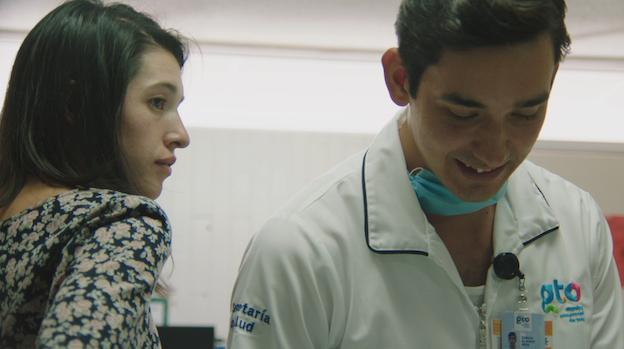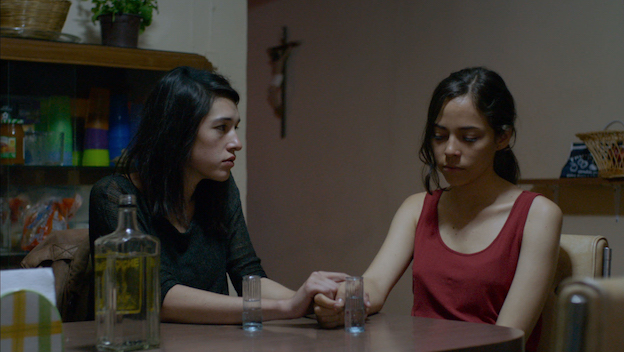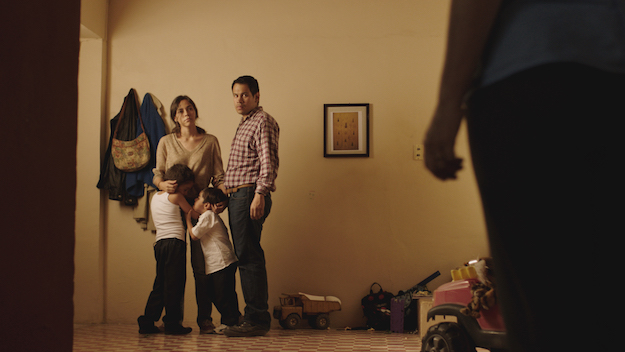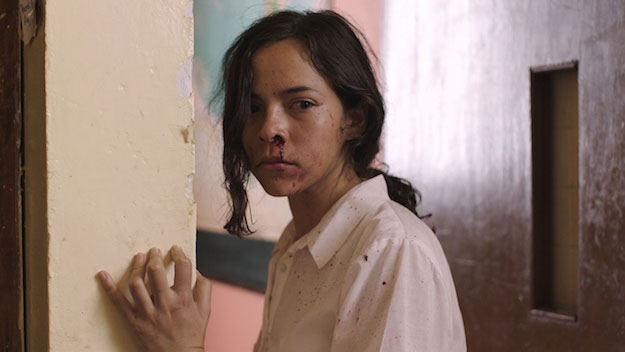Film of the Week: The Untamed

Show, don’t tell, they always say—but there are times in cinema when you’re shown things and you wonder whether a little discreet telling, perhaps just an allusive whisper here and there in the script, might have made all the difference. Horror juries are still out on the question of whether the fanged, snarling apparition of Jacques Tourneur’s Night of the Demon (57) should actually have manifested itself (although there are fewer horror icons that command more affection), while Stanley Kubrick quite clearly did the right thing in removing that roomful of cobwebbed skeletons from The Shining (Kubrickians, discuss). More recently, I’m still wondering about the airborne swirls of ectoplasm spied by Kristen Stewart in Olivier Assayas’s latest film Personal Shopper.
And now we have Amat Escalante’s new film The Untamed—or in its Spanish version, La Región Salvaje (“The Wild Region”)—which variously dazzled, horrified, shocked, and, in the case of some very nervous viewers, tickled the Venice Film Festival when it played in competition earlier this week. There is this… thing, let’s say, in The Untamed which is deeply unnerving to behold, and highly effective as a shock image, and you wonder whether we’d have been better off imagining it. If we had just imagined it, of course, The Untamed would be a very different film—and perhaps not an Amat Escalante film the proper sense.
Escalante is a very confrontational director, and someone not afraid to put disturbing images on screen in a very direct and you might say literal way. His last film, the drug war drama Heli, became the succès de scandale of Cannes 2013 largely because of a torture scene that coolly asked us to contemplate at length the spectacle of a man with his penis on fire. On CGI fire, that is—which at once made it possible to contemplate the image at all, and arguably defused its horrifying power. It’s hard to unpick the contradictions of CGI imagery—realistic? not realistic enough? too realistic?—on anything other than a case-by-case basis.

There are volumes to be written about this dilemma with particular reference to the horror genre—and to what you might call the art-horror sub-genre—and in particular to works like David Cronenberg’s eXistenZ, in which the hallucinatory creepy-crawlies are all the more calculated to get under our skin because we have been explicitly told that they’re digitally induced hallucinations within the narrative itself, which is about a hyper-real video game.
Anyway, there’s just a glimpse of this thing at the beginning of The Untamed, as we see a nearly naked young woman called Veronica (Simone Bucio) experiencing an ecstatic orgasm, with just a glimpse of some sort of tentacle withdrawing from between her thighs. Veronica then leaves the country shack where this takes place and heads home in some discomfort, with a bloody wound in her side: whatever the thing is, that’s some love bite it’s given her. After this disconcerting moment, the film comes down to earth and into the realm of mundanely ordinary small town life, as we meet the family of mother-of-two Alejandra (Ruth Ramos), who works making sweets in the factory of her domineering mother-in-law. Alejandra’s brother Fabián (Edén Villavicencio) is a nurse in the local hospital, where he ends up tending Veronica’s wound and becoming friends with her. Alejandra’s husband, meanwhile, is road worker Angel (Jesús Meza), a boorish homophobe—who happens to be having a sexually intense affair with his brother-in-law.
Whatever the thing is that lives in the shack—where it’s tended by two hippieish, scholarly elderly people—it has an intense sexual power that has already become dangerous for Veronica, and for some reason it’s now necessary for her to find it a new partner, or prey (the film works on that horror story logic by which victims of a curse, or here an ambivalent blessing, must save themselves by passing it on). “I think it’s going to like you,” Fabián is told—and it very probably does, because soon enough he’s found unconscious and naked in a pool in the countryside (a typical stylistic touch by Escalante—the body is at first barely recognizable, tucked away discreetly in the lower right hand of a wide shot).

What’s fascinating is the way that this ostensible excursion into genre—it must be science fiction, it starts with the image of an asteroid floating in space—remains for the most part determinedly earthbound, with one leg in the realm of the everyday, the other in that of family-based melodrama. One of the key turns comes when Alejandra discovers the barrage of violence-inflected sexting between her husband and her brother, and when Fabián winds up in a coma, she’s certain that Angel has put him there.
It can’t be long before Alejandra too makes friends with Veronica’s demon lover—which at one point appears like a coil of sentient rope hanging from the beams of the barn. It is that thing most calculated to make humans’ innards creep—maybe because it looks like innards itself—an octopus, or something like it (I defy you to watch The Untamed and ever again feel quite as cozy about Finding Dory). We could be talking about Cthulhu’s friskier younger brother (or sister, or sister-brother: we’re beyond the binary here).
Or we could be talking about metaphor, since the film seems to be really about the play of Eros and Thanatos and how they invariably fuck us up. But an image this tactile and concrete is bound to militate against abstract metaphor, and give us a sense of a supplementary, highly concrete something else.

There are two CGI shots in the film which might cause your jaw to drop, for whatever reason, or alternatively crack you up in nervous titters (as happened to the people annoyingly seated in front of me in Venice’s Sala Darsena). One of them I won’t describe because it’s just too outré not to be viewed without expectations, but the effects house must have had a ball working on it—a completely sui generis orgy scene, the sort of image which you probably have to be Lars von Trier to get away with. Or indeed, Amat Escalante. The other image actually shows Alejandra in the embrace of her demon lover, and apart from the fact that you may never touch calamari again, the image is horribly troubling, and resonant. It echoes one of those girl-meets-squid ravishings which are one of the more indigestible staples of a certain strain of anime erotica, and it also recalls—in a somewhat more mechanically rhythmic way, since Alejandra is moving as if on some perverse exercise bike—the thrashings of Isabelle Adjani and a similarly tentacled creature of the Id in Andrzej Zulawski’s notorious Possession. The film has something of Possession’s ominous, oppressive mood too, and it’s hard to imagine that the reference isn’t deliberate.
The thing is seen very graphically, in minutely realized detail, and that doesn’t make it, or its lovemaking, any less disturbing—this is one of those rare occasions when a CGI creation is imbued with absolutely real-seeming tactility, even a kind of sensuality. It makes perfect sense that we should see it—but the groundwork for its macabre spell is surely laid by certain moves in the film which are menacing and sinuous in their own right, like the seemingly unmotivated shots in which the camera creeps with intent around the passages near Alejandra’s home.
Meanwhile, the way The Untamed similarly creeps in oblique moves towards its revelation is equally unnerving. But it has something else that also unnerves and fascinates—the face of Simone Bucio, who has an insistent corrupt-innocent candor, and a look of permanent rueful anxiety that confirms what they always say: that the human face is one special effect too priceless to program.
Jonathan Romney is a contributing editor to Film Comment and writes its Film of the Week column. He is a member of the London Film Critics Circle.







